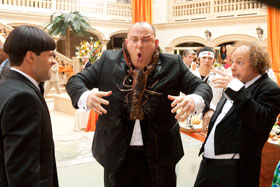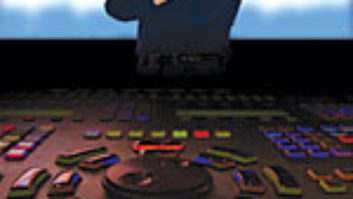
What makes a Stooge sound like a Stooge? Like when Curly gets conked on the head with a pipe or when Moe pokes Larry in the eyes? A certain generation knows those sound effects so well that it proved a challenge for the sound design team to create an instantly recognizable soundscape for The Farrelly Brothers’ new Fox release, The Three Stooges, that would consistently evoke from the audience the response, “Yup, that’s our boys.”
“We all have that library in our heads,” says first-call Foley artist and multiple Motion Picture Sound Editors Golden Reel Award nominee Dan O’Connell. “We all know what sounds ‘right’ and what doesn’t, when it comes to the Stooges.” Picture editor Sam Seig adds, “The comedy just doesn’t work with any other sound.”
It’s a dilemma faced by the Star Trek sound team, the Bond crew and any other number of editors/mixers who work in franchise properties that span decades: how to honor the past and yet make the new film sound modern. The Farrellys were decidedly looking for sounds that would evoke memories of those heard in the original Columbia shorts (produced from 1934 to 1958), but would also be relatable to 2012 audiences. Seig recalls that a first pass at the effects track didn’t feel exactly right to the directors. “They were really well done, of course, but they were just a little too perfect, in terms of sonic quality,” he says. “You have to remember, the originals were recorded by guys on soundstages with microphones, and they were recorded optically—which comes down to a blinking light creating a sound wave. And that’s very hard to replicate.” (For more information, see the sidebar “Classic Stooges.”)
A huge part of the Stooges’ comedy—and comedic timing—comes from the soundtrack. Columbia had released a library of sounds long ago, and while versions of the signature effects exist in many disparate forms today, the library hasn’t been around for decades. Still, Seig and his team took a pass through the film, trying to place original Stooges sound effects in the track, to see how they would fit.
“The co-writer on the film, Mike Cerrone, was our resident Stooge expert, and he was able to guide us to one short or another for a particular type of Stooge hit that was similar to one taking place in our film,” Seig explains. “We would look at that short, see what they were using there, and then dig through our libraries,” sometimes using sound libraries containing some of the Stooges sounds. “There are libraries that have been floating around Hollywood that sound editors have had for years, and we would just comb through those and find what we’d need.”
The resulting sound effects track for The Three Stooges is a medley of those sounds, as well as those created by O’Connell and sound effects editor Wayne Lemmer. “It’s sometimes difficult to re-create the charm of the original sounds,” Lemmer says. “If it doesn’t sound authentic, it doesn’t sound funny. So for each scene, it was just a matter of trying out what we recorded and hearing what they had placed in the track and seeing what worked best, what produced the biggest laugh.”

Foley artist Dan O’Connell prepares to give Curly a knock on the head, courtesy of a temple block.
Photo: Matt Hurwitz
O’Connell, co-owner with John Cucci of Foley house One Step Up, records direct to Pro Tools and has developed a variety of miking techniques over the years. In a very general sense, he likes to use Neumann U87s on the larger, fuller-sounding effects, like bangs and bops, and a Sennheiser 416 for the smaller squeaks and “smaller” sounds. He has spent decades creating realistic sound effects for hundreds of live action films, ranging from Natural Born Killers to Pirates of the Caribbean, as well as animated features, such as Kung Fu Panda and Alvin and the Chipmunks. “For the Stooges’ mayhem, they have to be funny sounds,” he explains. “They send that message right away, that a clang on the head isn’t hurting somebody—it’s a funny clang.”
Seig agrees. “Any other type of sound, and it turns into a horror film,” something he observed firsthand. “One of my guys played around and temped out a version of one of the Stooges big ‘slapfest’ fights with real effects, and I was just, ‘Ahhhhhh, stop hurting him!’ These effects don’t hurt.”
As Lemmer explains, while sound effects are typically built of multiple layers of elements to create a hyper-realisitc, detailed track, he notes, “When the Stooges were fighting, we went the exact opposite [way], using really simple sound effects played very boldly in the track.”
“The idea,” says O’Connell, ”was to just take stuff we had around the Foley stage and use them to re-create those sounds—just use the stuff we’ve played around with for years for animation, and throw them into the mix. You combine them all together and see what ends up being the funniest thing. If something is high [frequency], and then something is low—and then something has a kind of a wobbly sound—that always creates comedy. Mixing and matching helps quite a bit.”
A good old-fashioned Curly head knock—courtesy of a Moe hammer or metal pipe, of course—can be produced via dings with a sledgehammer on any variety of metal chunks O’Connell keeps on hand. “I have tons of different metal pieces, swords and pipes—things that clang,” he says. “Each one makes a different tone. Originally, they probably just took different pieces of metal and tried out different things, until they got something they really liked—because that’s what we do. You do it until you go, ‘I recognize that sound; that’s the right clang. That’s the Stooges.’”
An animation staple, the temple block, also provides a good knock on the head. “I’m sure they used these, as well,” O’Connell says, “because that sound is really clear in the original tracks. And when I do it, I crack up. Also, for Curly’s head, clanking a good bottle produces a good ‘ping’ sound—if it doesn’t break. We have certain wine bottles that I can throw down 100 times and they won’t break. That’s a good bottle!”

Foley artist Dan O’Connell finds the perfect sound for a Curly ear-turn, twisting a metal shoehorn against an old Honda car door on the Fox Foley stage.
Photo: Matt Hurwitz
Crushing pine cones came in handy for those punishing nose-crunches Moe likes to deliver, something O’Connell learned on his Pirates work for ghostly bodies covered in seashells. And a properly plucked violin produces the trademark Stooge eye poke. “You have to hold it correctly, to deaden the chord,” O’Connell explains. “You don’t want it to be a ringing tone. And you have to pluck it. So when you pull it together, and let it go, it does the ‘boink,’” which he demonstrates.
Then there’s the all-important Larry hair tear. The Foley artist uses a combination of a variety of wigs, a cloth or canvas tear, depending on the frequency desired—and a third special ingredient. “This stuff,” he says, pulling out a large wad of green Easter basket grass. “If you pull it, it makes a really good tear,” something he discovered on a more realistically violent project, Heaven and Earth, where a villain grabs a woman by the hair and drags her. “We did that and just said, ‘Let’s use that again later on.’”

Squeaks—such as when Curly sticks his finger in his ear to scratch an itch—are produced by squeezing and rotating the rubber tip on an old cane, recorded close-miked. A chunk of bark grazing a cheese grater subs in for a similar action on Curly’s scalp. And an old long-handled shoehorn, twisted against the metal of an old car door, produces the perfect nail-pull heard when Moe gives Curly’s ears a good crank or is being pulled along by his nostrils. “It sounds like stretching, and then you add a pop, and that combination makes it very funny.”
Dialog editor Dave Butler had his work cut out for him in such scenes. “I effectively had to carefully remove the production track sounds—all the slaps and hits, which had to be replaced with the Stooge effects sounds,” he explains. “It’s quite surreal watching a Stooge fight scene and not hear anything, save for the ‘effort’ grunts, etc., that remained.”

The final mix was created in mid-February on Fox’s Howard Hawks Stage, by a threesome of top re-recording engineers: Andy Nelson (music), Jim Bolt (dialog) and Anna Behlmer (effects). “It’s not very often you get a three-person crew,” says Bolt, who normally handles music and dialog on projects. “It really allows you to focus on one part, to take your time and put in more detail. And you’re able to enhance it with each pass through, which is nice.”
The sound effects in the track, Bolt notes, are louder, in some respects, than in a more typical comedy. “In Stooge fashion, there are plenty of them, but they’re over quickly and then it’s back to the puns,” he says. “As for level, we try and stay out of the pain threshold; we don’t want to hurt the audience because they’ll disconnect. And, oddly, the apparent loudness is more than what the real sound pressure level is. A little compression and EQ go a long way toward enhancement.
While The Three Stooges places the boys in a modern setting, the sounds of their performance can only exist in their world. “The thing that was great about doing The Three Stooges was having the opportunity to do a live action film, but using the animation theory of sound effects,” says O’Connell. “In animation, we get to do those crazy, funny sounds all the time. And to be able to do them in a live action film was really a blast.”





